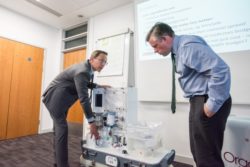Jon Ashworth MP, the shadow health minister, saw a selection of technological innovations during a fact-finding visit to Oxford.
He took part in a roundtable discussion with innovators and entrepreneurs who are helping to secure better care for NHS patients by harnessing the full potential of new technology. It was organised and hosted by Oxford University Innovation at the Oxford Science Park.
Jon Ashworth was accompanied by the Oxford East MP Anneliese Dodds. Other contributors to the discussion included Lord Paul Drayson and representatives from:
- Drayson Technologies – who demonstrated the SEND patient monitoring system
- Brainomix – who demonstrated stroke imaging solutions
- OrganOx – who demonstrated a liver perfusion device
 Oxford Academic Health Science Network Chief Operating Officer Dr Paul Durrands also took part, providing an overview of the AHSN’s work, particularly around the spread and adoption of clinical innovations. He is pictured, centre, with Lord Drayson, left, and representatives of Brainomix.
Oxford Academic Health Science Network Chief Operating Officer Dr Paul Durrands also took part, providing an overview of the AHSN’s work, particularly around the spread and adoption of clinical innovations. He is pictured, centre, with Lord Drayson, left, and representatives of Brainomix.
Lord Drayson highlighted Drayson Technologies’ roll-out of GDm-Health, a remote monitoring system improving life for pregnant women with diabetes which was developed by clinicians, researchers and engineers in Oxford and supported by Oxford AHSN. Read more about it here.
Jon Ashworth MP said: “Ensuring that the NHS provides UK citizens with timely access to innovative technologies developed here is a concern shared by many. We’ve seen some fantastic technologies that can save lives and resources demonstrated here in Oxford, and have learnt a lot from the experiences that have been shared.”
Adam Stoten, Chief Operating Officer of Oxford University Innovation, said: “The highly collaborative nature of the relationship between the University of Oxford and our two local NHS Trusts means that we are well positioned to combine deep insight into clinical environments and working practices with interdisciplinary academic creativity; the result being transformational medical innovations that work in the real world.”
Anneliese Dodds MP said: “It’s really important that NHS patients can quickly get access to promising new technologies that will improve their health. It’s been terrific to see how many of these technologies are being developed here in Oxford. We’ve also learned about what more can be done to ensure speedy take-up of innovative technologies throughout our NHS.”


